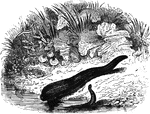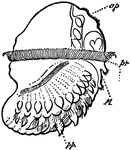This gallery offers 156 ClipArt images of worms. Worms are a general term given to many invertebrate animals that have a long, soft body and no legs.
Leech
Leeches are characterized by the fact that they have no lateral appendages, but are furnished with a…

Leech
Leeches are characterized by the fact that they have no lateral appendages, but are furnished with a…

Leech
A class of suctorial worms found in bodies of water, marshes, and other moist places. There are many…
Leech
"Alimentary system of leech. m., Mouth; cr6., sixth crop-pocket; cr11., last crop-pocket; v., rectum;…

Leech Dissection
"Dissection of leech. c.g., Cerebral ganglia; p., penis; s.v. is opposite the semminal vesicle; ov.,…
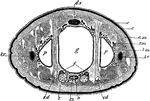
Leech Section
"Transverse section of leech. c., Cuticle; e., epidermis; c.m., dermis and outer muscles (circular and…

Horse Leech
The horse leech, similar to the medicinal leech, feeds chiefly on earthworms and on other leeches.
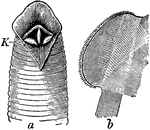
Medical Leech
"Head of Hirudo medicinalis, showing the three jaws (k); b, one of the jaws isolated, with the finely…

Liver Fluke Stages
"Life history of liver fluke. 1. Developing embryo in egg-case; 2. free-swimming ciliated embryo; 3.…

Liver-fluke
Liver-flukes live parasitically within other animals, primarily birds and fishes. They are all more…

Lob Worm
"Dissection of lob-worm from dorsal surface. m., Opening of retracted buccal cavity; i., gullet; gl.,…

Lob-worm
"Errantia means wandering, and is applied to numerous species, of which the Lob-worm or Lug-worm,…
Lugworm
"Arenicola marina. Entire animal viewed slightly from left side. Note anterior mouth; setae on anterior…
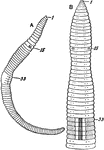
Lumbricus Agricola
"Lumbricus agricola. A, entire specimen, lateral view; B, ventral view of anterior portion of the body,…
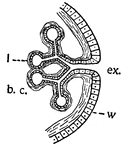
Lungs
This is a diagram illustrating lungs or tracheae. b.c., the cavity in which the body fluids circulate;…

Medicinal Leech
The medicinal leech is a leech used in bloodletting. It lives in fresh water, and is common in Germany,…
Terebella medusa
"Distinguished by their habit of forming a tube or case, within which the soft parts of the animal can…

Mesoderm
"Modes of forming mesoderm. A and B, special mesoblasts distinguishable early in egmentation (annelid):…
Microstomum
"Diagrammatic sagittal section of Microstomum, showing a chain of four zooids produced by fission. b,…
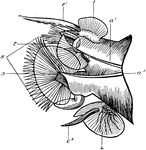
N. Pelagica
"Parapodium of "Heteronereis" of Nereis pelagica. 1, 2, 3, 4, the leaf-like outgrowths; c1., notopodial…
Nais
"In their form they resemble the common earth-worm; but their bodies are furnished, besides the ventral…
Nematode
"Diagram of the structure of a male Nematode. M., mouth; OE., oesophogus; GA., nerve ring; B., bulb…
Nemertea
"Diagrammatic longitudinal section of a Nemertean (Amphiporum lactifloreus), dorsal view. p.p., Proboscis…

Nephridium
This illustration shows a representation of the circulation of the blood, in its essential features.…

Nereis
A diagram of of the nephridium of Nereis. Nereis is a genus of polychaete worms in the family Nereidae.…

Nervous System of the Flatworm
Nervous system of a flatworm. Labels: G, cerebral ganglia and eyes; St, the two lateral nerve trunks;…

Oligochete Worm
This illustration shows the arrangement of the nervous material in the anterior end of an Oligochete…

Peanut Worm - Interior Anatomy of Adult
Sipunculus nudus. A species of unsegmented marine worm, commonly called the peanut worm. "A, One fourth…

Peanut Worm - Interior Anatomy of Larva
Sipunculus nudus. A species of unsegmented marine worm, commonly called the peanut worm. "B, Larval…

Plathelminth
"A., a minute portion of the branched excretory system of a Plathelminth, showing longitudinal duct…

Plathelminth
"B., one of the characteristic hollow flame-cells, leading into the excretory tubule (1), showing the…

Polygordius
"Development of Polygordius. a., Mother sperm cell; b., c., sperm morulae; d., spermatosoa. 1. Ovum…
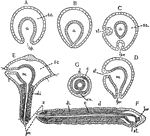
Polygordius
"Diagrams of stages in the metamorphosis of Polygordius, a primitive annelid. Ectoderm throughout is…

Polymoë
"Elytrum of Polymoë, a polychaetous annelid, bearing fimbriae, viewed from above." -Whitney, 1911
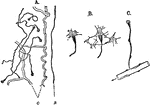
Protonephridium
Structure of the protonephridium (excretory organ) of a flatworm. A, part of the excretory apparatus…

Protonephridium of an Annelid
Structure of the protonephridium (excretory organ) of an annelid. Labels: Wtr, ciliated funnels; Ds,…

Ptychodera Flava
"Ptychodera flava (New Caledonia), from above; about life size." — The Encyclopedia Britannica,…
Rotifers
The rotifers or wheel-animalcules are relatively small and beautiful organisms, rarely ever longer that…

Roundworm
In the Trichina, a parasitic roundworm, the bodies of several animals, particularly the rat, are host…

Scale Worm Nervous System
"Esophageal Ring. Anterior end of nervous system of Polynoë, a polychaetous annelid, showing, a,…
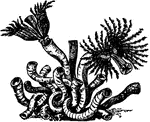
Serpula
"Serpula, a genus of Polychaete worms of the family Serpulidae, whose members construct coiled calcareous…
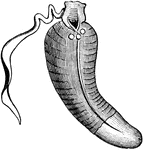
Spoon Worm
Echiurus gaertneri is a species of spoon worm considered annelids, though they are not segmented.

Stenostoma
In this Turbellarian the digestive tract (d.t.) is a blind sac. st., boundary of stomodaeum and mesenteron;…

Tape-worm
Tape-worms live parasitically within other animals, and are often spoken of as Entozoa. This is an egg,…

Tape-worm
Tape-worms live parasitically within other animals, and are often spoken of as Entozoa. This is a bladder-worm,…

Tape-worm
Tape-worms live parasitically within other animals, and are often spoken of as Entozoa. This is a head…

Tape-worm
Tape-worms live parasitically within other animals, and are often spoken of as Entozoa. This is a single…
Tape-worm
Tape-worms live parasitically within other animals, and are often spoken of as Entozoa. This is a fragment…
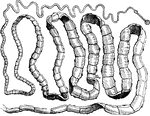
Tape-worm
"The body is composed of numerous joints or segments, each one resembling the others; these are often…

Tapeworm
Probably the most widely known of the flatworms are the tapeworms. These are parasites in the digestive…
